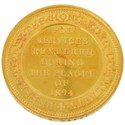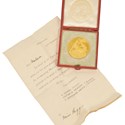Catherine Southon’s sale includes a gold Hong Kong Plague Medal from 1894 which was issued to Elizabeth F Higgin. ‘Sister Frances’ was a nurse who died four years later in another outbreak after a patient coughed in her face and she contracted bubonic plague.
The inscription on her grave reads In loving memory/ of/ Elizabeth Frances / 3rd daughter of William and Frances Higgin born 21st Sep. 1861/ died 29 April 1898/ of plague contracted on duty/ for nearly eight years a member of/ the Government Civil Hospital/ in HK/ Blessed… [last bit illegible].
According to the Medal Yearbook, the colonial authorities in HK awarded the medal to “nurses, civil servants, police, British Army and Royal Navy personnel who rendered assistance when the crown colony was struck by a severe epidemic of bubonic plague in May 1894. Despite stringent measures, over 2500 people died in the ensuing three months”.
About 400 medals were issued in silver and awarded to 300 men of the King’s Shropshire Light Infantry (KSLI), 50 petty officers and men of the RN and NCOs and other ranks of the Royal Engineers, as well as about the same number of police and junior officials. Around 45-50 medals were struck in gold for officers, nursing sisters and junior officials.
Gold award
Higgin’s gold example is estimated at £5000-8000 at the auction in Selsdon, Surrey.
As a good value comparison, a silver plague medal was sold by Ipswich auction house Lockdales in January last year. The honour named to Private P Fahey of the KSLI made £1400 (plus a 17.25% buyer’s premium), and was bought by an Australian dealer. The vendor was a UK collector. In July 2014 London saleroom Spink sold another KSLI plague medal awarded to Private W Bissell for the same hammer price.
Information from thesaleroom.com shows that Dreweatts sold another KSLI medal in August 2011 for £1000, while Dix Noonan Webb has sold eight since 2007, ranging in hammer price from £1200-1650.
The 1st battalion of the KSLI was stationed in HK when bubonic plague broke out in May 1894.
Volunteers were called out for work on plague relief. According to the Shropshire Regimental Museum, men of the KSLI served at various times on deeply unpleasant tasks. Despite the risk, just 10 men from the regiment fell ill and only two men died.
This KSLI contribution was recognised by the local community partly through the presentation of this plague medal. The award was unofficial, so the men were unable to wear it in uniform. Many were converted to wear as brooches or watch-fobs.
Original case
Higgin’s gold medal is offered in its original fitted Wyon red leather presentation case, together with a short presentation letter from the Honorary Secretaries, dated September 25, 1895.
It has been consigned from the estate of the late Patrick Thomas Corrie Lewin, descendant of Brigadier-General Arthur Corrie Lewin, who married Nora Higgin (sister of Elizabeth Higgin.)









